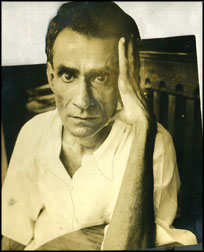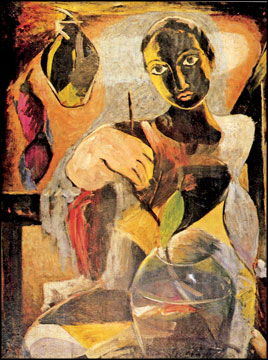|
Justin Deraniyagala:
Never at war with life
by Tissa HEWAVITARANE
|

Justin Deraniyagala
|
Most people see only ugliness in suffering. They are repelled at the
spectacle of pain. But few people are raised to the heights of religious
and aesthetic exaltation at the experience of misery. They find lips of
the spirit with which to feed upon the substance of sorrow and to
transform it into beauty. Such a man was Justin Pieris Deraniyagala the
painter.
Justin Deraniyagala was a rare phenomenon - an artist who was never
at war with his life. His days were spent intranquillity. His even
temper enabled him to a life of undisturbed calm. If we want to find
drama in Deraniyagala we must look at his paintings rather than his
life. He regarded and recorded the sufferings of humanity, like a
spectator who watches a shipwreck from a sheltered vantage point upon
the shore. Deraniyagala was one of the most objective of painters.
Education
|

A painting by Justin Deraniyagala |
As the son of the late Sir Paul E. Pieris Deraniyagala was born in
Colombo on 20 July 1903. He had his early education at S. Thomas's
College, Mount Lavinia. His first art training started at 'Atellier' Art
School under Mudaliyar A.C.G.S. Amarasekera and with Bergen at Training
College and also C.F. Winzer. In 1921 he left for England entered
Trinity College, Cambridge. In 1924 he obtained B. A. degree in Law and
Bantam Weight Boxing Blue. Thereafter, he entered the Slade School of
Fine, Arts, London. He obtained the first prize for drawing in 1928.
After many years in London and Paris studying and working with the
best of European painters he came under the influence of great modern
masters such as Pablo Picasso, Henri Matisse and Georges Braque. His
notes drawings and sketches on canvases are considered among the great
in contemporary paintings. His paintings have attracted, fascinated
attention of many art lovers not only in Sri Lanka but in Western
Europe.
In 1935 after returning to Sri Lanka he worked in the British Museum
on Ceylon antiquities and with Malinowski. With many more international
exhibitions behind him he was elected vice president, Ceylon National
Committee of International Association of Art.
Deraniyagala's subject matter has always been the human figure,
usually female. His themes are largely universal ones. His paintings are
all human, all - too human and that is why to this day they are able to
arouse so sympathetic a response within us. We recognise them at once as
our friends. For their thoughts are our thoughts, their feelings are our
feelings, and their hopes are our hopes. They represent the aspirations,
the struggles the dreams, the achievements, the disappointments, the
sufferings and above all faith and courage of mankind. Deraniyagala
continued to paint his cynical pictures of human character with endless
feelings. His subject matter was not beauty as such, but the human
figure, especially women `the girl with gold fish', 'the Bride', Girl
with mirror' done often using dark muddy murky tones on canvases. One of
the famous portraits painted by a Sri Lankan artist, is `The Blue Nude'
and another painting done in the 1920s was of Josephine Baker, the
American born French entertainer and singer.
He won the UNESCO awards at the 28th Venice Biennial the world's
biggest exhibition of contemporary art for his painting titled. `The
Fisherman'. One of his paintings is reproduced by the UNESCO as a colour
print.
In 1943 with some of his friends he formed the 43 group. He sent his
work to London in 1952 through 43 group. Justin Deraniyagala was one of
the seven Sri Lankan painters of the 43 group whose work was hung at
Venice. The credit for putting Sri Lanka on the world's artist map goes
mainly to the 43 group.
Justin Deraniyagala was one of the few Sri Lankan painters to be
popular in the West very early in his life. John Berger, an art critic
of the New Stateman and Nation thinks of Deraniyagala as a philosopher
painter. Maurice Collins art critic once wrote the introduction to a
Deraniyagala exhibition at the Beamx Art Gallery. London as I venture to
assert that there is no expressionist painter in England today who is
equal in craftsmanship or whose mood is so bold and various. He has
humour, tenderness, gaiety and strong feeling. His painting has great
quality. His handling is continually that of a master. A magisterial
personality emerges from his canvases".
Throughout his life he remained a bachelor. During his later years
with his increasing ill-health worked at Nugadola, his village home in
Pasyala. The hundred of sketches and drawings including water-colour
paintings never left his studio in his lifetime, but came to light only
after the artist's death. His paintings had all the colour, vigour, and
power they are always noted for.
He died at the age of 64, on May 24, 1967 at Nugedola, Pasyala after
a lifetime of dedication to his art.
www.tissahewavitarane
|

